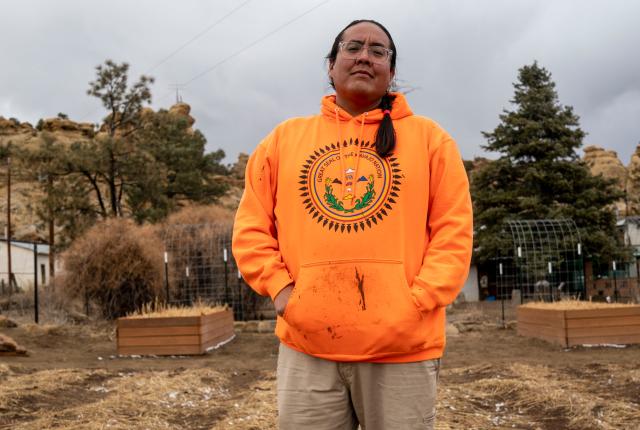AT AROUND 6 A.M., JOSHUA TODDY (DINÉ) WAKES UP, grabs his jacket, and steps outside to release 25 chickens from their coop onto his one-acre homestead in Nahodishgish, near Crownpoint. He grows tomatoes, kale, carrots, and other vegetables in eight raised beds—fed by an automated drip-irrigation system he developed using captured roof-runoff—near a small orchard. Passionate about gardening while growing up on the Navajo Nation, Toddy now shares his knowledge with more than 152,000 followers on TikTok as the High Desert Gardener. For the past 10 months, the former manager of an additive manufacturing lab at Navajo Technical University has also worked as on-site manager at the nonprofit Hózhó Voices of Healing Center, in Borrego Pass. In addition to teaching workshops and creating a garden of Indigenous foods, Toddy and the center’s staff are working on land restoration projects within the center’s 1,733 acres and re-establishing a flock of Navajo-Churro sheep.
I NEVER HAD TOYS GROWING UP. I never wanted cars or action figures. I always took off to the garden center. That’s all I ever wanted.
WHEN I CREATED MY TIKTOK on Christmas Eve 2020, everyone was in quarantine. I said, “What’s something unique I can share?” It came down to gardening.
GARDENING HERE, where I live, there are almost no trees. It’s flat, very dry, and windy—a lot of challenges.
I’VE MADE so many mistakes. So I started sharing my gardening journey.
IT’S NOT IMPOSSIBLE. Before commercial agriculture, Indigenous peoples farmed these lands for thousands of years. Whatever water fell, we captured that.
I DIDN’T REALIZE how much people really want to know about growing their own food and becoming more self-sufficient.
CHICKENS ARE MY HELPERS in the garden. They till the soil to get rid of bugs, and I have a compost pile in a chicken coop.
IN 2014, Diné College and the Diné Policy Institute came out with a report on tribal food sovereignty in the Navajo Nation. One thing the report centered on was where people get their food. Over half of them travel off the reservation for groceries, and some people drive as far as 240 miles round trip.
SEEING ALL THESE STATS laid out for you—that’s a huge disconnect between our food system and what we’re doing.
THE CLEAR ANSWER is we need to grow food ourselves. But how do you go about doing that? People have become reliant on the supply chain to get their food.
I WANT TO TEACH my community, my region, how to grow their own food in our climate.
WE TALK ABOUT generational trauma. Even now, there are a lot of wounds that people deal with out here.
I’M THE HAPPIEST in the garden, outside, working with the land, having my hands in the soil, working with my animals.
I’LL BE OUT THERE at sunrise and then in the evening. After a hard day’s work, I’ll just sit in the garden and be in peace, being quiet and enjoying the sounds of nature. That’s where I started to heal myself.
AT THE HÓZHÓ CENTER, a big part of it is healing. The goal is to get back to our way of living prior to colonization—going back to living off the land. We herded sheep, we silversmithed, we made rugs. We had our own local economy.
WE WANT TO hearken back to old traditional ways to help with that trauma.
WE’RE GOING TO BE A HUB for people to come to learn these skills and bring back that knowledge. If we can encapsulate all of these things we used to do, I think it will make us more resilient.
SEE FOR YOURSELF
Find Joshua Toddy (@highdesertgardener) and the Hózhó Center (@hozhocenter) on TikTok. Take a seed-starting and soil-health workshop at the Hózhó Center on May 6. hozhocenter.org


